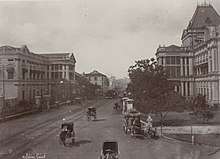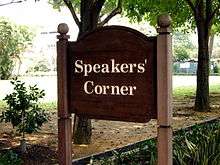Hong Lim Park
Hong Lim Park (Malay: Taman Hong Lim, traditional Chinese: 芳林公園; simplified Chinese: 芳林公园; pinyin: Fānglín Gōngyuán), formerly Hong Lim Green and Dunman's Green, is a 0.94-hectare (2.3-acre) heritage park in Singapore that is "the only venue in Singapore where public protests are allowed", next to Clarke Quay MRT station.[1]
| Hong Lim Park | |
|---|---|
| Originally named Dunman's Green Subsequently renamed Hong Lim Green | |
Hong Lim Park photographed in March 2006 | |
.svg.png) Location in Singapore | |
| Type | Heritage Park |
| Location | Singapore |
| Nearest town | Chinatown, Singapore |
| Coordinates | |
| Area | 0.94 hectares (9,400 m2) |
| Authorized | Singapore Government |
| Owned by | National Parks Board |
| Administered by | National Parks Board |
| Open | 24 Hours |
| Status | Open |
| Public transit access | NE5 Clarke Quay |
| Facilities | Open-Air Theatre, Public toilet |
History
Dunman's Green was one of the earliest public parks in Singapore,[2] it was named after the first Superintendent of Police Thomas Dunman who retired in 1871. In 1876, it was renamed as Hong Lim Green in honour of Cheang Hong Lim (Chinese: 章芳林; pinyin: Zhāng Fāng Lín), a wealthy Chinese Hokkien businessman and philanthropist who bought and donated the land to the government.

In 1885, a Mansard roofed Police Courts building known as the Criminal District and Magistrates' Courts, was built on the grounds of the park. The North Canal Post Office was also built in the area, which was situated closer to the North Canal Road, while the Police Courts building was situated closer to the South Bridge Road. The first Straits Chinese Recreation Club clubhouse was built at the centre of the park, an octagonal pavilion designed by H.D. Richards, was officially opened to members by Chinese consul Tso Ping Lung on 2 July 1887.[3] In 1914, the original clubhouse was demolished for the construction of a new pavilion, which had improved lighting and facilities and had its entrance facing New Bridge Road.
Hong Lim Green would start its first storytelling tradition during the Japanese occupation of Singapore in the 1940s. After the war, it was used as a cricket ground by members of the Singapore Chinese Recreation Club and the Singapore Cricket Club, and was also the venue for many of the first political speeches and election rallies in the 1950s and 1960s.[4] With Singapore Chinese Recreation Club vacated the premises in 31 July 1959 and moved to Shenton Way, its former clubhouse's demolition started on the following day to make way for new developments.[5]
Hong Lim Green was refurbished by the City Council of Singapore with new grass turf, a sand filled children’s playground, a fountain, park facilities, and an open-air theatre was built at a cost of S$173,000, it was renamed to Hong Lim Park and officially reopened by S. Rajaratnam on 23 April 1960.[6]
On the following day, the Telok Ayer Hong Lim Green Community Centre, which was behind the open-air theatre, was officially opened by Dr Goh Keng Swee.[7] The storytelling tradition was once again resumed in another medium as Chinese operas were performed at the open-air theatre from 1960s to 1970s. The park had also became an attractive location for cultural shows, outdoor movie screenings and election rallies once again in the 1960s to 1970s. In 2005, the Hong Lim Park Open Stage was refurbished to incorporate a modern-looking pure Teflon tentage that preserved the historical stage layout of the 1950s.[8]
The Criminal District and Magistrates' Courts, which had remained at the park for 90 years, was demolished soon after the Subordinate Courts was opened for operation on 15 September 1975, the site of the former police courts building is currently an empty field with a toilet facility to cater as part of the event venue. The park's playground had since been removed.
The former North Canal Post Office had been renovated and converted into the Kreta Ayer Neighbourhood Police Post in the late 1980s, would also served as a registration centre for anyone who wishes to give speeches or set up events at the Speakers' Corner from September 2000 onwards.
Speakers' Corner
Hong Lim Park was selected by the government as the venue for Speakers' Corner on 1 September 2000. Since then, it is the only place in Singapore where one can legally stage public protests. In early 2013, two protests against the government's immigration policies each drew more than 350 people, and in June 2014, about 20 people protested the Central Provident Fund (CPF), Singapore's state-run pension fund.
Gallery



 Fountain at Hong Lim Park.
Fountain at Hong Lim Park.- Former North Canal Post Office, currently North Canal Neighbourhood Police Post
 Speakers' Corner sign
Speakers' Corner sign- Open air theatre, behind Telok Ayer Hong Lim Green Community Centre.
 Notice at stage, behind Telok Ayer Hong Lim Green Community Centre.
Notice at stage, behind Telok Ayer Hong Lim Green Community Centre.- Telok Ayer Hong Lim Green Community Centre

Geography
The park was bounded by North Canal Road, South Bridge Road, Upper Pickering Street and New Bridge Road. Telok Ayer Hong Lim Green Community Centre and the Kreta Ayer Neighbourhood Police Post lie adjacent to the park. Adjacent to the park are the Telok Ayer Hong Lim Green Community Centre and the Kreta Ayer Neighbourhood Police Post.
Getting there
By bus:
- Bus services 186, 568, 575, 588, 599, 723, 735 and 970 are available at Upper Pickering Street.
- Bus services 2, 12, 33, 54, 147, 190 and 767 are available at New Bridge Road.
- Bus services 2, 12, 33, 51, 61, 63, 80, 174, 174e, 197, 961 and 961M are available at Eu Tong Sen Street at Exit A of Clarke Quay MRT station.
References
- Wong, Chun Han (8 June 2014). "Protesters Assail Singapore Pension System". Wall Street Journal.
- "Plan of Singapore Town Showing Topographical Detail and …". www.nas.gov.sg. Retrieved 2018-03-28.
- Singapore, ?? National Library Board. "Chinese Recreation Grounds & Police Court in the 1880s : general view | PictureSG". eresources.nlb.gov.sg. Retrieved 2018-03-28.
- https://www.nparks.gov.sg/gardens-parks-and-nature/parks-and-nature-reserves/hong-lim-park
- "Down comes a S'pore landmark". Retrieved 2018-03-28.
- "The playground and open-air theatre at the park in Hong Lim …". www.nas.gov.sg. Retrieved 2018-03-28.
- http://www.nas.gov.sg/archivesonline/data/pdfdoc/lky19600423.pdf
- Tor, Ching Li (21 November 2005). "In Hong Lim Green a CC gets a facelift". TODAY. Singapore.
